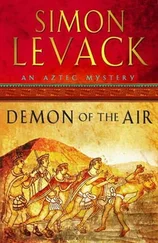There is almost nothing left of Laconte’s fort these days. What was once here has either slowly eroded with time or since been picked off piece by piece by bored kids or scavengers of American history, who have carted away what little remains to homes and workshops where the past is minutely and painstakingly re-created. The large stones that once served as the fort’s first line of defense against attack are fortunately still relatively intact, being far too large and heavy to be lifted away in the night. To some degree they are the real reasons I’m here — these large, unpolished stones, carried here block by block by teams of horses. After the gun they are the first real signs of modern warfare in America, and speak to the old European tendency to draw boundaries and solidify ownership. These stones say unequivocally, This is mine, and everything that I can see beyond these walls is mine as well.
The battle that was fought here must have been a remarkable, vicious sight: long and meticulously planned to draw out the forts’ inhabitants one wave at a time for the slaughter. The stones had served their purpose well. No one as it turns out was killed behind their walls, and all who died here did so outside in the open field, either running for their lives or pleading for mercy.
These are just some of the facts that I’ve since picked up about Fort Laconte and the battle in 1687 that brought it to an end. There are other facts as well, although none as personally relevant. For example, the fort had a prison inside its walls, even though it never at any point had more than one hundred inhabitants, all of whom knew each other well and had traveled for months and years up and down the Mississippi coastline together, exploring and claiming the new frontier for France. The prison was used only once against a member of the expedition as punishment for hoarding food in the winter when rations were scarce. It was used on multiple occasions to hold captured Tamora Indians who had remained from the beginning hostile to the presence of Jean-Patrice Laconte and his men. The men who were held here were often tortured. Their wrists and ankles were bound together for days at a time. They were hung upside down, beaten, flayed, and almost always starved. They died quickly from hunger or disease.
The fort took five months to construct. The outer walls were approximately fifteen feet high and nearly a foot thick. There was a storage shed for munitions and another for food. Jean-Patrice Laconte had his own private stable built inside the fort’s walls for his two favorite mares to make sure they would never be slaughtered if there was ever a food shortage.
One great difference between the fort as it stands today and as it appeared to my father and mother thirty years earlier is the wooden fence built around the remains. The fence is minor, and if it had not been for the “Do Not Enter” signs posted every couple of feet along its wall, I would have probably walked around it in search of the entrance gate. As it stands, there is no gate, or if there is one it is surely locked and would be as difficult to get through as the fence itself.
The guard has returned to his shoebox. From where I’m standing I can see him clearly through the side window. His body is perched over the day’s newspaper, his hat lying harmless inches away. His vigilance has tired itself out and he’s gone back to being just another ordinary man, concerned with the day’s sports news and politics. I don’t know if I have the right to feel a certain pride at having been able to put him to rest, but I do anyway. It’s just as I had hoped. I am not a man to be feared or worried over; I have a face that even a skeptical stranger could learn to trust.
I take the long way around the perimeter of the fence, ducking into the shade cast by a nearby copse of trees — white elms with glistening, almost translucent trunks. Near one I find a spot almost completely hidden from view. I place my hands on top of the fence and hurl my body smoothly over to the other side where the shade is even thicker, the grass still damp with dew. It’s been said that the only way to truly know any history is to walk in its footsteps. People the world over make pilgrimages to this or that historical landmark to do precisely that. They congregate on Civil War battlefields, at grave sites, and at the homes of the dead to get a glimpse of the past as it must have looked a century or millennium ago. I can’t say that my aims here are quite so grand, and even if they were, there isn’t much left here for me to imagine. This place is an historical landmark in only the strictest sense of the phrase, to the degree that almost any piece of land on this earth could be said to be of significance to someone.
What happened here between my parents late on a September afternoon thirty years earlier is, I have to admit, largely a matter of wild and perhaps even errant speculation. The events of 1687 are shrouded in less mystery than those of that day. In effect, 1687 has more going for it than 1977, and I don’t think it would be wrong to say that I can see clearer the causes and effects of a battle more than three hundred years old, along with the lives that fought and died in it, than I can understand my parents, who for their part always remained strangers to me.
Looking at the remains of the fort — its size and scope, its proximity to the forest and to the spring that runs alongside it — I don’t think anyone who came here did so expecting or wanting to fight. Laconte’s fort is more defensive than anything else — an extra precautionary measure for a man who knew he was on hostile ground. After most of the men here were killed, a nearby garrison of French soldiers was sent in to investigate and if possible capture or kill the Tamora warriors who had raided the fort. In the official report written by Captain Pierre-Henri Scipion, a simple, rhetorical question is asked, almost as if by accident, near the end of the last paragraph. Why, Pierre-Henri wanted to know, didn’t Laconte equip the fort’s walls to defend against an attack? I can see what he means now. There are hardly any cracks or holes along the fort’s wall to defend from. When the fort was attacked the men inside had to either shoot blind from over the top or risk their heads. You could say this was an accident, or an oversight, or a criminally stupid thing to do on the part of Laconte, but that would fly against the facts, in defiance of all reason and logic. Laconte was a decorated and well-known soldier of two different wars. He had lost his right hand in one battle and had been injured on multiple occasions both before and after. He was not a man who took risks lightly. He knew how to defend. This I imagine is why Scipion asked his question, which would be better served if it were rephrased to say, What could make a man like Jean-Patrice Laconte, citizen of France, battle-scarred veteran of two wars, father of six, and friend of Robert de la Salle, construct a fort where it was all but impossible to kill your enemy as he advanced?
The answer is simple, and if Scipion saw this place as I see it today, I wonder if he wouldn’t rethink his question, or if he wouldn’t perhaps refrain from asking it at all. Arriving as he did so shortly after the battle, he could still see bloodstains on the grass and on the white bark of the trees where men caught trying to escape were bound and then executed. There were broken weapons, axes, muskets, discarded bits of ammunition, unpaired shoes lost while running, bits of torn cloth from shirts, pants caught on branches, and the sense of a great, heaving tragedy lingering in the air. Looked upon like that, it would be impossible to see this meadow as anything other than a graveyard in the waiting — a spot designated if not by divine providence, then at least by history for bloodshed and massacre.
Читать дальше











